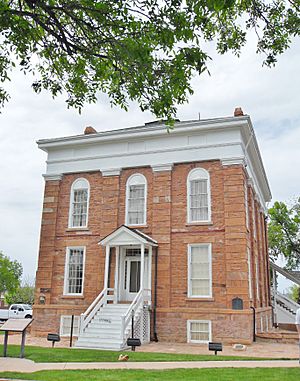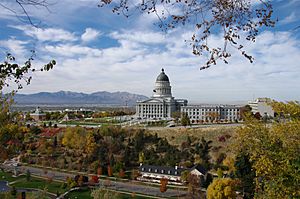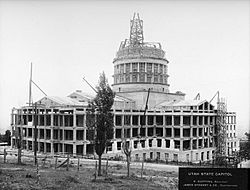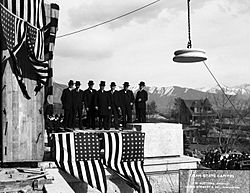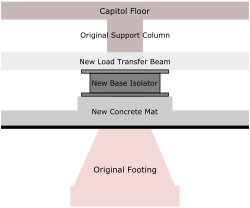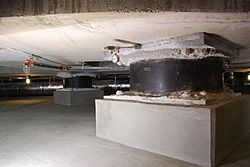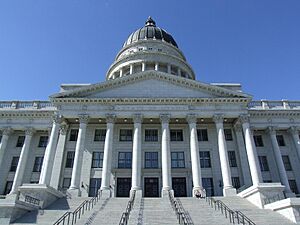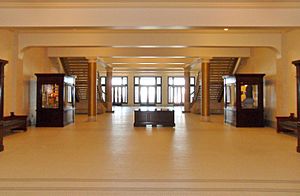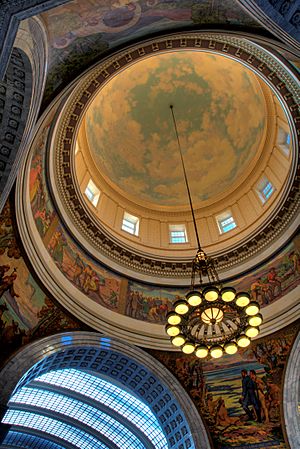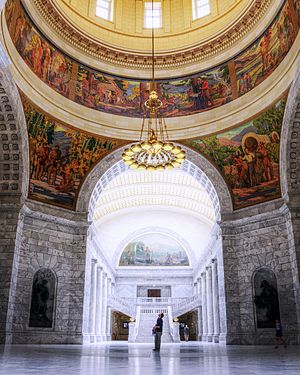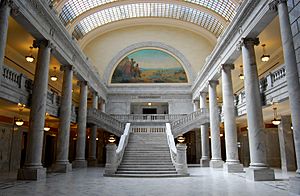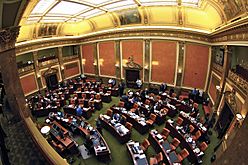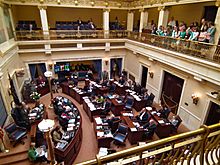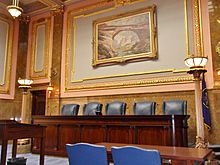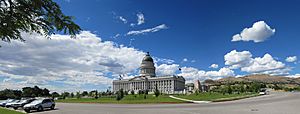Utah State Capitol facts for kids
Quick facts for kids Utah State Capitol Building |
|
|---|---|
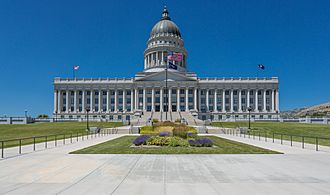 |
|
| General information | |
| Architectural style | Neoclassical Revival, Corinthian style |
| Location | Capitol Hill, Salt Lake City, Utah, United States |
| Coordinates | 40°46′38″N 111°53′17″W / 40.77722°N 111.88806°W |
| Construction started | December 26, 1912 |
| Inaugurated | October 9, 1916 |
| Renovated | 2004–2008 |
| Cost | $2.7 million |
| Renovation cost | $260 million |
| Owner | State of Utah |
| Height | 285 ft (87 m) (dome) |
| Technical details | |
| Floor count | 5 |
| Design and construction | |
| Architect | Richard K.A. Kletting |
The Utah State Capitol is where the government of the U.S. state of Utah works. This important building holds the rooms and offices for the Utah State Legislature, which makes laws for the state. It also has offices for the Governor, Lieutenant Governor, Attorney General, and the State Auditor.
The capitol is the main building in the Utah State Capitol Complex. It sits on Capitol Hill, looking over downtown Salt Lake City. The building was designed by architect Richard K.A. Kletting. It has a Neoclassical revival style with Corinthian columns. Construction happened between 1912 and 1916. In 1978, the building was added to the National Register of Historic Places. From 2004 to 2008, the capitol had a big restoration and renovation. This project added two new buildings and brought back the original look of many public areas. A special "base isolation system" was added to help the building survive a strong earthquake. After the updates, the building reopened in January 2008.
Contents
Early Government Buildings in Utah
The first Euro-American settlers arrived in Utah on July 24, 1847. This day is now celebrated as Pioneer Day. These settlers, led by Brigham Young, asked the United States Congress for statehood in 1849. They wanted to create the State of Deseret. Their request was denied.
However, in September 1850, the U.S. Government created the Territory of Utah. A group called the Utah Territorial Legislature was formed to govern the territory. This group met in different buildings, like the Council House. This building was first built to be the capitol of the State of Deseret.
Choosing a Capital City
One of the first things the assembly did was choose a capital city. On October 4, 1851, Millard County and its capital, Fillmore, were created. The area was named after President Millard Fillmore. It seemed like a perfect central spot for Utah's capital.
Construction on Utah's first capitol building, the Utah Territorial Statehouse, began the next year. Architect Truman O. Angell designed the building. The U.S. Congress gave $20,000 for the project. This money was not enough for the whole building, so only the south wing was finished.
In December 1855, the fifth Utah Territorial Legislature met in the building. This was the only full session held in Fillmore. The next year, the legislature met there again. But they soon moved to Salt Lake City. Lawmakers complained about not enough housing and facilities in Fillmore. So, in December 1856, Salt Lake City became Utah's capital. The statehouse in Fillmore was no longer used. Several buildings in Salt Lake City served as temporary homes for the legislature. These included the Council House and, starting in 1866, the Salt Lake City Council Hall.
Building the Capitol
Early Plans for a Capitol
Over time, the smaller buildings were not big enough. Many leaders and business people wanted a new, permanent capitol building. They asked Salt Lake City to donate about 20 acres (81,000 m2) of land. This area was called Arsenal Hill. On March 1, 1888, the City Council agreed to give the land to the government.
A "Capitol Commission" was created to plan the new building. They chose Elijah E. Myers to design it. He had also designed the state capitols in Michigan, Texas, and Colorado. His plans were ready by 1891. However, they were rejected because the estimated cost was $1 million.
Plans for a capitol were then put on hold. This happened after Utah was allowed to plan for statehood. On January 4, 1896, Utah officially became a state. The Salt Lake City and County Building was used as the capitol for the new state.
Designing and Funding the Capitol
By 1909, Utah still did not have its own capitol building. Governor William Spry asked the state legislature to create a new commission. This commission would oversee the building's construction. In 1909, the commission was created. They worked to get money for the project.
A bill to use a property tax for funding failed. So, they looked into bonds and loans. In 1910, the state constitution was changed to allow borrowing money for the capitol. By 1911, a bill for $1,305,000 in bonds was presented. The amount was lowered to $1 million and passed. Governor Spry signed it into law in Spring 1911.
Funds also increased when Union Pacific Railroad president, Edward Henry Harriman, died in 1909. His widow had to pay a five-percent inheritance tax to Utah. Union Pacific helped build the Transcontinental Railroad in Utah. Harriman had also invested in Salt Lake City's electric trolley system. Because of these ties, Mrs. Harriman paid the state $798,546 on March 1, 1911.
With funding secured, the commission started planning the building and its grounds. The Olmsted Brothers from Massachusetts were chosen to design the landscaping. There were concerns about the cost of leveling the steep Capitol Hill site. In December 1911, a committee looked at other locations. Some suggested Fort Douglas or downtown Salt Lake City. But in the end, they decided to build on the original 20 acres (81,000 m2) Capitol Hill site. They also tried to buy more land around it.
The commission decided to hold a design competition for the building. This was common for public buildings then. The competition rules included required size and number of floors. The total cost had to be under $2 million. The rules were approved on August 30, 1911. Information was sent to architectural firms.
Twenty-four firms were chosen to compete. Some withdrew because the payment was less than expected. The list was shortened to eight firms. Final designs were due on January 12, 1912. After reviewing designs, the commission narrowed it down to two: Richard K.A. Kletting's and Young & Sons'. On March 13, 1912, Kletting's design was chosen by a vote of four to three. After being selected, Kletting visited other capitols in the eastern United States. The Kentucky State Capitol influenced his final designs. His first detailed plans were due on July 15, 1912.
Building the Capitol
After Kletting's detailed plans were ready, contractors could bid on the work. Bids were opened on December 3, 1912. James Stewart & Company won the main contract on December 19, 1912. P. J. Morgan got the contract for digging and leveling the site. The groundbreaking ceremony for the capitol happened on December 26, 1912.
A lot of soil had to be removed from the hillside. The eastern side of the site was as high as the building's fourth story. A steam shovel dug into the hill. It then put the dirt into a small temporary train. This train carried the soil to nearby City Creek Canyon to be dumped. After the base was ready, work on the foundation began. The capitol would be built of stone with a concrete and steel frame.
By spring 1913, the foundation and basement walls were in place. Steel columns and wooden frames for the concrete were being installed. Many small shops and offices were built on the hill to support the construction. Small railroad lines carried stone, mixed concrete, and other supplies. Contractors built a new railroad to bring granite from a quarry in Little Cottonwood Canyon.
On April 4, 1914, Governor William Spry led the cornerstone-laying ceremony. The cornerstone, dated 1914, was placed at the top of the southern steps. It contained records and photos about the building's construction and Utah's culture.
By late summer 1914, the basement, second floor, and outer walls were almost done. Columns were being installed, and work on the dome progressed. The dome was covered in Utah copper. The capitol commission wanted the work to go fast. They hoped the legislature could meet in the building the next year.
However, by the end of 1914, work was not far enough along. The legislature met in the Salt Lake City and County Building in 1915. On February 11, 1915, the session moved into the new capitol. Even with the legislature meeting there, it took over a year to finish the rest of the building. This allowed executive and judicial officers to move in.
The capitol was officially dedicated on October 9, 1916. The original construction cost was $2,739,538.00. The building was added to the National Register of Historic Places in 1978. It is part of the Capitol Hill Historic District.
Renovation and Restoration
In summer 2004, the capitol closed for a big renovation. This included restoring parts and making it stronger against earthquakes. The project had three main goals. First, make the structure strong enough for a 7.3 magnitude earthquake. Second, restore the building's original design and art. Third, make sure the building still worked well after the renovation.
On August 7, 2004, the day before the capitol closed, a "Capitol Discovery Day" was held. The public was invited to learn about the changes. By August 8, the renovation had already started in some areas. In 2002, after the 2002 Winter Olympics, some newer buildings on the campus were torn down. Construction began on two new buildings north of the capitol. These would serve as temporary offices during the restoration. Much of the asbestos on the dome's exterior was removed that summer.
Some major improvements included updating heating, cooling, plumbing, and electrical systems. Many rooms were returned to their original size. Others, like the Senate Chamber, were made larger. Rooms were repainted their original colors. New carpets, matching the 1916 originals, were installed. The 550 original windows were replaced with new, energy-efficient ones. Some were even bulletproof. Original furniture was restored, and new period furniture was bought. The rotunda floor, which originally had glass to let light through, was restored with glass.
The building's dome received a lot of attention. The dome's base had leaked water for many years. Instead of terracotta, the state had used stucco and plaster. This caused water damage to the murals inside. To stop this, the dome was coated with asbestos. During the restoration, the asbestos was removed. Real terracotta replaced the leaking plaster and stucco. Inside the dome, a cathodic protection system was installed. This system uses electricity to prevent damage to the concrete and steel. A new six-inch concrete wall was added inside the dome for strength.
The biggest part of the renovation was making the building earthquake-resistant. A base isolation system was installed underneath. This system has 280 base isolators. Each is 20 inches (51 cm) high and 36 inches (91 cm) to 44 inches (110 cm) wide. Installing them meant digging around and under the capitol. The original support columns were connected to new beams. These beams were supported by pile caps around the building. The columns were then detached from their old foundations.
A new concrete mat was poured around the old foundations. The base isolators were placed on this mat. Once all isolators were in, the building rested on them. The isolators are made of rubber layers. They are strong vertically but flexible horizontally. This allows the building to sway gently during an earthquake.
Other improvements also increased stability. Concrete shear walls were added inside. These walls prevent the building from twisting during an earthquake. They were put in old vent shafts and new elevator shafts. The granite columns outside were also strengthened with epoxy.
This renovation was the first of its kind on such a large scale. The final cost was $260 million. This did not include two new legislative office buildings, which cost $37 million each. The capitol was rededicated on January 4, 2008. It opened to the public the next day. The total cost for the capitol complex makes it one of the most expensive state capitol complexes in the United States.
Capitol Architecture
Exterior Design
The capitol's design was inspired by Classical architecture. Some newspapers compared early designs to Greece's Parthenon. Many details use the Corinthian style. This style focuses on formality, order, balance, and clean lines. The building is 404 feet (123 m) long and 240 feet (73 m) wide. The dome is 250 feet (76 m) high.
The outside is made of Utah granite. This stone comes from nearby Little Cottonwood Canyon. Other Salt Lake City landmarks, like the Salt Lake Temple, also use this granite. The stone front is balanced, with a main entrance on each side. Fifty-two Corinthian columns, each 32 feet (9.8 m) tall, surround the south, east, and west sides.
Interior Design
The building has five floors: four main floors and a basement. The capitol is decorated with many paintings and sculptures. These show Utah's history and culture. You can see statues of Brigham Young, the first territorial governor. There is also a statue of Philo T. Farnsworth, a Utah native who helped invent electronic television. The floors are made of marble from Georgia.
Basement Level
The basement has been changed a lot over the years. Much of the eastern half now holds the base isolators for earthquake protection. Because of the sloped ground, the western half still has a full basement. During the 2004-2008 restoration, a terrace was built around the building. This extended the basement level beyond the original walls. Today, the basement has maintenance and security offices. It also has meeting rooms, a printing office, a bill room, and a fitness center.
First Floor
The first floor, or ground floor, was the first part completed. It has the fewest decorations. The outside stairs on the east and west sides lead to this level. The front steps lead directly to the second floor. When it opened in 1916, this floor was mostly a large, open exhibit space. Offices were in the four corners. The ceiling under the rotunda is made of glass. This glass also forms the floor above, letting light shine down. Over time, the open areas were divided into more offices. Now, the first floor still has many exhibits. It also includes a small visitor center and gift shop.
Second Floor
The second floor is often called the main floor. It has kept much of its historical look. This floor is also the first level of the three-story rotunda and the areas next to it. The rotunda is in the center of the building, under the dome. The inside ceiling of the dome is 165 feet (50 m) high. It has a large painting by William Slater. This mural shows seagulls flying among clouds. The California gull is Utah's state bird. It represents the Miracle of the gulls from Utah's history.
Inside the dome is a cyclorama. This is a circular painting with eight scenes from Utah's history. These scenes include the driving of the Golden Spike and the naming of Ensign Peak. The people in the cyclorama are about 10 feet (3.0 m) tall. When the capitol opened in 1916, the cyclorama was blank. It was painted in the 1930s as a Works Progress Administration project.
The dome is supported by marble arches. These arches each show a scene from Utah's history. They include the exploration of Utah by John C. Frémont and the Domínguez–Escalante expedition. They also show fur trapping by Peter Skene Ogden and the arrival of the Mormon Pioneers. At the bottom of the dome are niches with statues. These niches were empty until the recent restoration. Three artists created four statues to fill them. These statues, called "The Great Utahs," are about Science and Technology, Land and Community, Immigration and Settlement, and Arts and Education.
The original chandelier hangs from the dome's ceiling. It weighs 3,000 lb (1,400 kg). The chain supporting it weighs another 1,000 lb (450 kg). This chandelier is a copy of one in the Arkansas State Capitol.
On the east and west sides of the rotunda are atria. These have large skylights that let sunlight into the public areas. Around the atria are two levels of balconies. These are supported by twenty-four large Ionic style columns. At the end of each atrium is a marble staircase and a mural. The mural on the west end, above the House Chamber entrance, is called Passing of the Wagons. The mural on the east end, above the Supreme Court entrance, is called Madonna of the Wagon. Both murals honor the early pioneers.
The state reception room, or gold room, is also on this floor. It is used to welcome important visitors. The room is called the gold room because of the many gold leaf decorations. The ceiling has a painting called Children at Play. Most of the furniture and decorations in the room came from Europe. The Governor's office is just west of the gold room.
Third Floor
The third floor, also called the legislative floor, holds the rooms for the House and Senate. It also has the Supreme Court chamber. When the building first opened, the library was in the northeast corner. It has since moved, and that area is now smaller offices.
At the end of the west atrium is the entrance to the House of Representatives. The House has 75 members. They serve two-year terms and represent about 40,000 citizens each. During the restoration, the House chamber was returned to its original colors and carpets. Two large plasma screens were installed for voting and presentations. New desks were made to look like the originals but can hold modern technology. The chamber ceiling is a large skylight.
The chamber also has four murals on its rounded ceiling. Two are original, and two were painted during the renovation. The east mural, The Dream of Brigham Young, shows Young near the Salt Lake Temple. The west mural, Discovery of the Great Salt Lake, shows Brigham Young talking with Jim Bridger about the Great Salt Lake. The north mural shows Seraph Young voting in Utah's first election after women's suffrage was granted. The south mural shows the Engen brothers building their first ski jump. This represents the importance of outdoor recreation to Utah's economy. The House Lounge, behind the chamber, was restored to its original size and furnished with period items.
The Senate chamber, where the Utah State Senate meets, is in the northern part of the center wing. The Senate has 29 members who serve four-year terms. Senators face north, toward the speaker. The chamber was expanded during the renovation. It now includes what were once hallways. Like the House, the Senate Chamber was restored with original colors and furniture. It has three murals. The first is original and covers the front wall. It is a landscape by A.B. Wright and Lee Greene Richards showing Utah Lake. During the restoration, two new paintings by Keith Bond were added. The eastern mural, Orchards along the Foothills, shows the Wasatch Mountains. The western mural, Ancestral Home, shows an Anasazi ruin in the red-rock hills of Southern Utah.
The Supreme Court chamber is at the far east end of the building. It is now only used for special events. The Utah Supreme Court moved to a new courthouse in Salt Lake City in 1998.
Fourth Floor
Historically and after its renovation, the fourth floor has viewing galleries for the House and Senate. It also has several offices and committee rooms. Much of the floor is open, allowing visitors to look down on the third or second floors. When the capitol opened, this floor was also an art gallery. Currently, it has several small exhibits and a statue of Philo Farnsworth, the television developer.
Capitol Grounds and Complex
The capitol building is the main feature of a 40-acre (160,000 m2) area. This area also includes a Vietnam War memorial, a Utah Law Enforcement Memorial, and a monument to the Mormon Battalion. The renovations added a new plaza, a reflecting pool, and two office buildings. There is also underground parking. The grounds feature plants and trees native to Utah. They offer great views of Salt Lake City, the Salt Lake Valley, and the Wasatch Front.
Other Buildings in the Complex
State Office Building
By the 1950s, the capitol was getting too full. There was little room to add offices without changing the historic layout. So, the state legislature approved $3 million to build a new office building. It was located about 350 feet (110 m) north of the capitol. A new plan was created to connect the two buildings with a plaza. This plaza would cover a new underground parking area. Other parking lots were expanded, and a maintenance shop was built. The plan also set aside space for two more office buildings.
The new building was designed by Scott & Beecher Architecture. It was smaller than the capitol but had more usable office space. Construction began on March 8, 1959. A lot of dirt was removed for the new building. This dirt was used to build up the ground for Interstate 15, which was also being built then. The new building was dedicated on June 9, 1961. This building is planned to be torn down in 2021. It is not strong enough for an earthquake, and tearing it down is cheaper than fixing it. Offices from this building started moving in January 2020 to a different location.
House Building
The Rebecca D. Lockhart House Building is on the west side of the capitol complex. It mainly holds offices for members of the Utah House of Representatives. The lower floor has several committee rooms. The upper floor has the Office of Legislative Research and General Counsel.
Senate Building
The East Senate Building is on the east side of the capitol complex. It has more offices for members of the Utah Senate. The main floor has The State Room, a dining room for the Capitol Café. The second floor has two committee rooms. A private lounge for lobbyists is located under this building.
Artwork on the Grounds
The capitol grounds feature several artworks, including:
- Statue of Daniel C. Jackling by Avard Fairbanks
- Edward Harriman Memorial
- Statue of Thomas L. Kane by Ortho Fairbanks
- Statue of Martha Hughes Cannon by Laura Lee Stay Bradshaw
- Statue of Marriner S. Eccles by Mark DeGraffenried
- Vietnam, Cambodia, and Laos Veterans Memorial with a bronze soldier statue by Clyde Ross Morgan and a circular wall by Mark Davenport
There are 22 statues, monuments, and plaques in total. Spaces are set aside for several more in the future.
See also
 In Spanish: Capitolio del Estado de Utah para niños
In Spanish: Capitolio del Estado de Utah para niños


